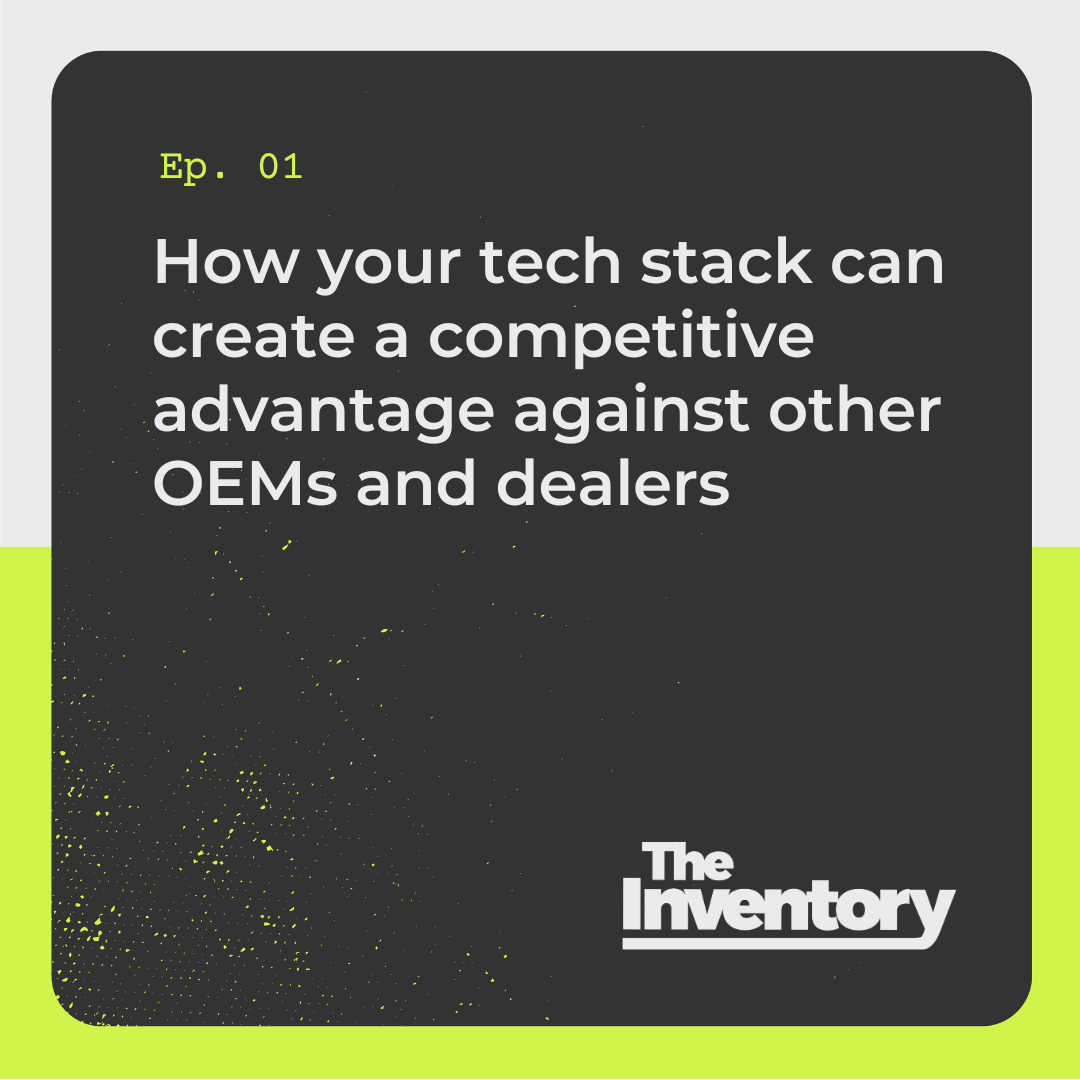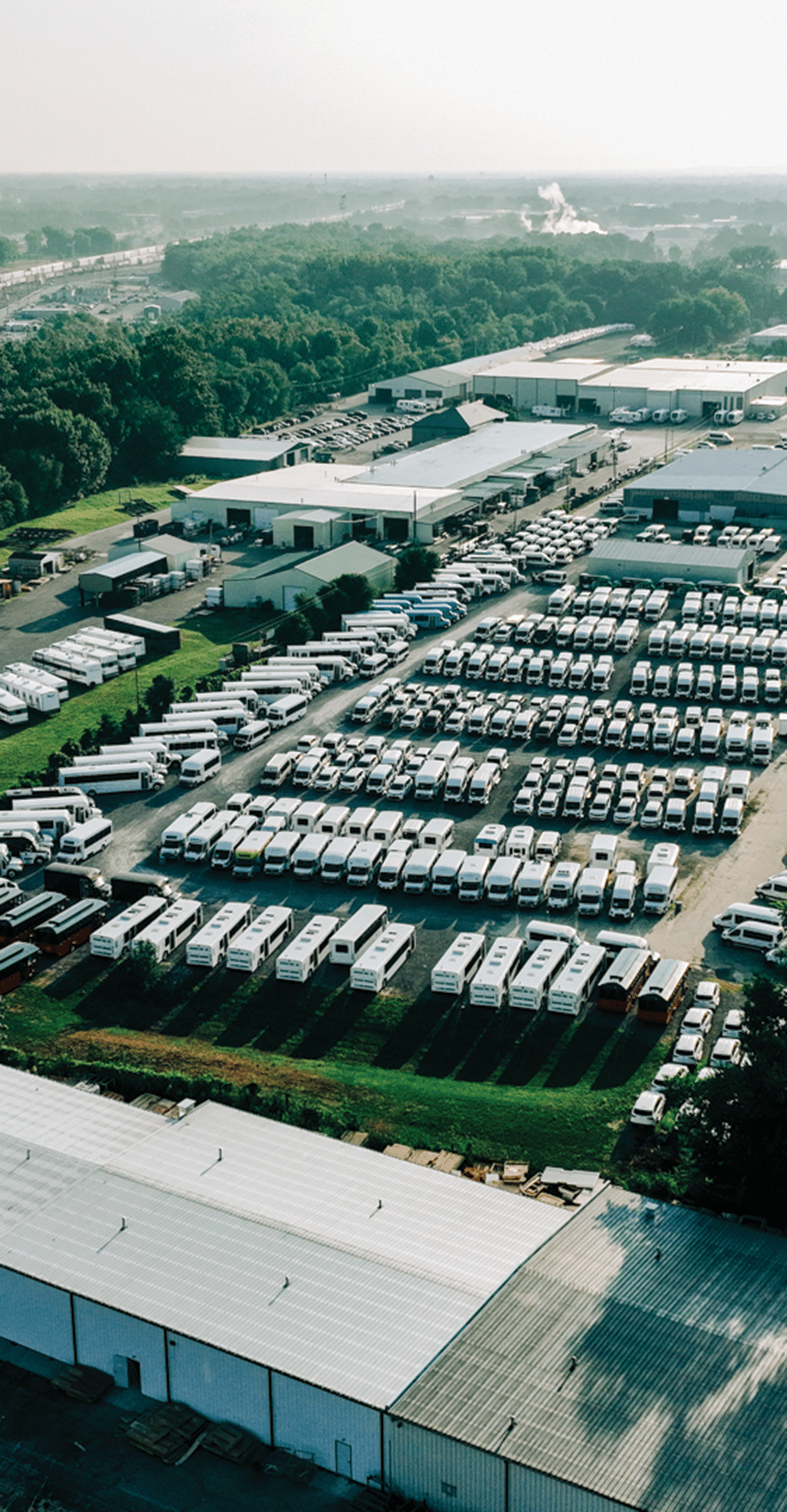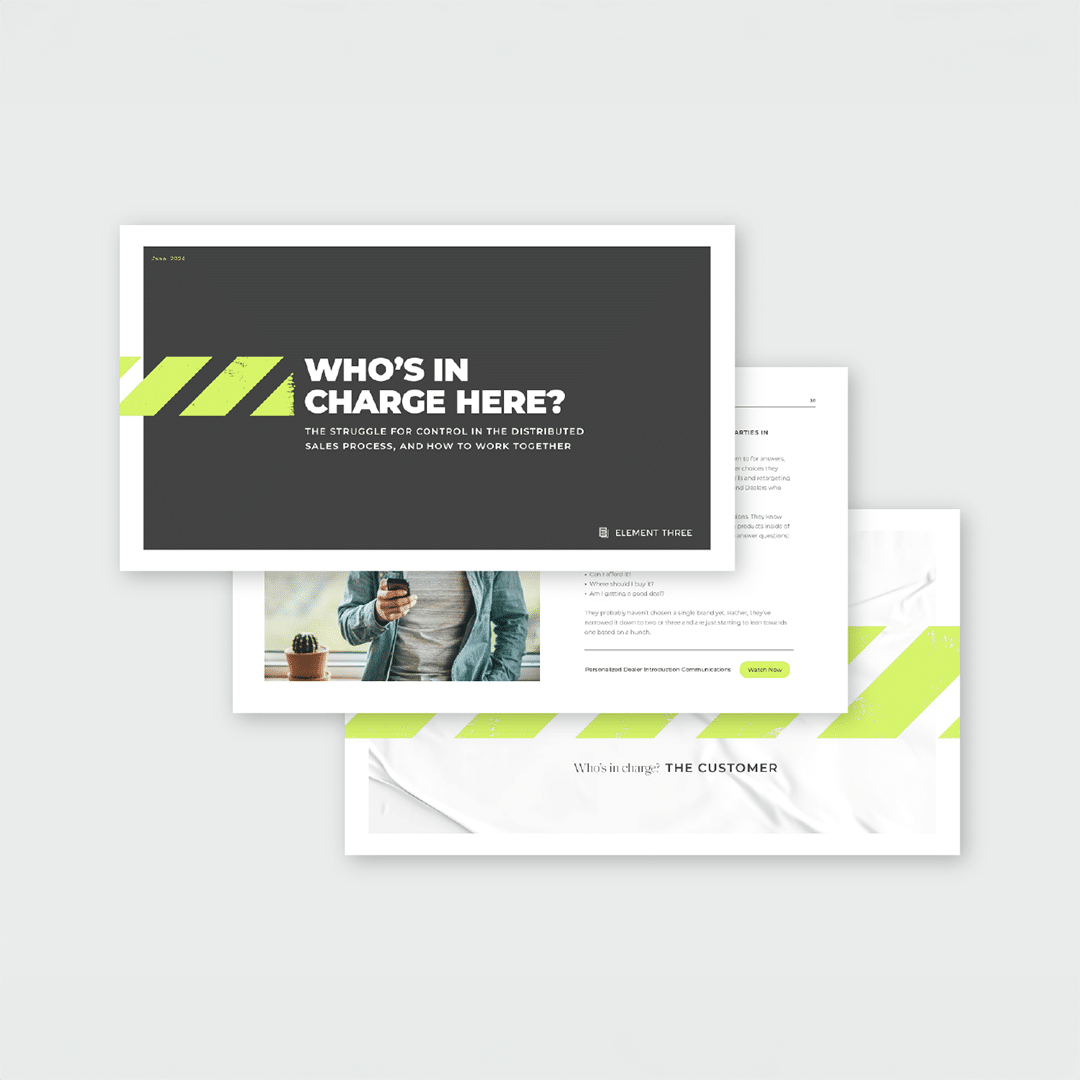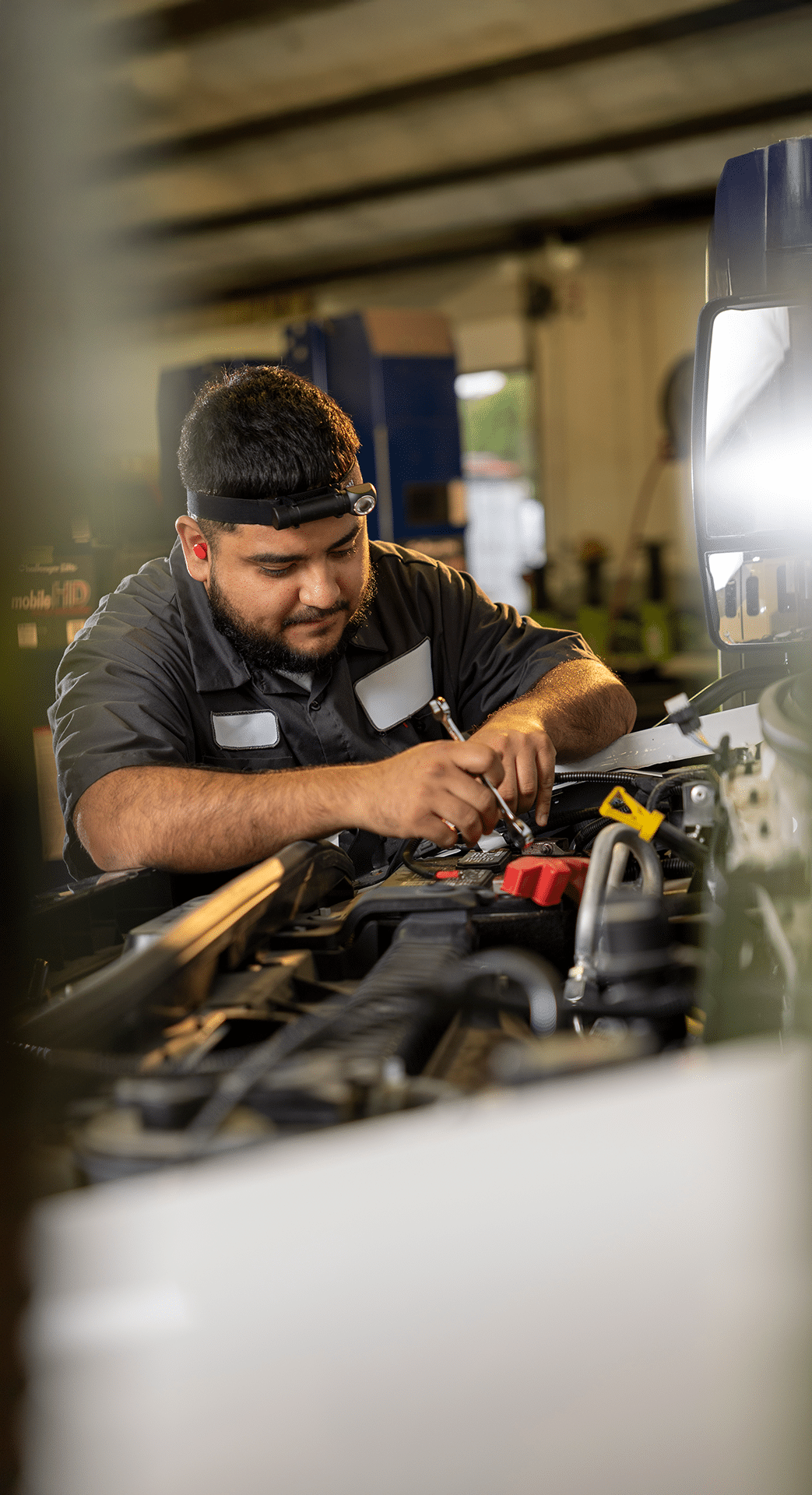Research: Changes, Challenges, and Opportunity in the OEM-dealer Dynamic
Get more out of your OEM-dealer relationships and move more inventory together with original research conducted by Element Three. Read the insights below.
ABOUT THE RESEARCH
Any business that operates in a channel distribution model knows that a gap exists between the original equipment manufacturer (OEM) and their dealers. That gap varies from relationship to relationship, and it’s not insurmountable. But research we conducted shows that there are changes, challenges, and opportunities that exist in this area that aren’t always being addressed.
This research report outlines some of those areas for improvement, plus provides several strategies we recommend for OEMs to better manage their dealer network—as well as ways to increase ROI from your marketing efforts, move more inventory, and start meeting more of your annual goals.
Insight #1
The Deal with Dealers
OEMs are experiencing challenges with their dealer networks. That’s not necessarily a new f inding, but what’s interesting is why. Uncertainty and changes in the market are creating tension between manufacturers and their dealers, in part because of the diversity that exists within the network. Many OEMs struggle to provide consistent support across the board—especially between large, consolidated dealers and small, mom-and-pop type shops.
That said, despite some challenges, our research found that OEMs and dealers share a drive for mutual success—including increasing their commitments to customer satisfaction, more collaboration and openness between OEMs and dealers across the network, and opening more efficient methods of communication.

What OEMs Can Do
Segment Dealers
Dealers—like end-customers—should be segmented. Territories don’t need to, and probably shouldn’t, overlap in order to give everyone the best opportunity. This also allows you to better segment leads and deliver them to dealers who are most likely to win the business based on location.
Handle Technology
It’s easier for some dealerships to keep up with shifts and changes in digital marketing and new sales processes than others. That creates a natural technological gap between the OEM—who can afford to invest in new tech—and their dealers. Finding a solution that works across the network, and assisting in the rollout through investment and training, can help maintain a level playing field.
Consistent Training
Sales and service roles at the dealer level often see high-turnover. This requires a regular investment in training from the OEM—and not just on the product. Successful OEMs are training on the selling points of the product, benefits of the brand, and more. The more connected a salesperson feels to the OEM’s brand, and the more confident they are in pushing the product, the more likely the sale (especially on a mixed lot).
Bridge the Gap
As consolidation continues in both OEM and dealer sectors, there’s a wider disparity opening up. Large, multi-location corporate dealers are able to invest more heavily in areas like digital marketing and even hire staff to serve in those roles specifically. In contrast, family-owned dealerships can’t dedicate the same kind of cash or manpower to compete. OEMs have the ability to provide the kind of assistance they need to overcome that imbalance
We train on product knowledge – we do not teach sales process, but did talk about the selling points of product, the value add over others.
The best OEMs build dealer programs that align with the business environment to support market needs.
For example, some heavy equipment OEMs in agriculture build inside and outside sales teams around geographic regions, so distributors have relevant local knowledge to serve the end consumer. In Marine, we see more alignment around product type because the use case matters more than where you put the boat in the water.
- Dealers want to be supported by OEM technology—not slowed down or constrained
- Through mergers and acquisitions, large dealers can often outpace the OEM in terms of technology sophistication
- Technology can be tiered based on opportunities in a given market, and confidence in dealers in the area
- If confidence in a dealer or group is lacking, aim for better communications, stronger relationships, or new partners
Hear from industry peers & expert marketers
Learn where other OEM and dealer leaders are placing bets and making hard choices in their businesses the Why You Win podcast. Or tune into The Inventory to hear how to better leverage your technology and marketing tactics to move units.


Insight #2
Overcoming Inventory Issues
Inventory comes and goes—except when it doesn’t go. And that has proven to be a source of tension between dealers and OEMs. If inventory isn’t moving, what is there to do?
This, too, isn’t a new problem—or even one that’s unique to the dealer environment. The inventory aspect of the relationship will always be there, and until there’s some way to create perfect equilibrium in the “old product out, new product in” process (spoiler alert: that’s probably not coming soon), friction will continue to exist.
What to do, then? We recommend finding other ways to create efficiency and ease to help mitigate these tensions.
What OEMs Can Do
Transparency in Communication
Dealers want to know more. And they rely on OEMs to tell them more. Are there changes in strategic plans? Ways the manufacturer is dealing with a challenging market dynamic? Will these updates have an effect on the dealer? Even if the answer is no, it’s best to have an open dialogue with the dealer network to assuage their concerns and explain ways these new policies are trying to make life better for them.
Better, More qualified leads
Like we mentioned above, technology can be a sticking point between dealers. However, when there’s a new system put in place that helps level the playing field, OEMs can then focus on delivering a better qualified lead to them. The more of these that dealers get, the happier they’ll be. (And it helps solve that inventory problem.)
More investment in dealer programs
Dealer programs are admittedly tricky. When different dealers have different needs, it takes a large scope to provide the kind of assets in a dealer program that can benefit everyone. Yet that is exactly why investment in dealer programs is important. Benefitting the entirety of the dealer network “raises all ships.”
Thorough product and brand training
Dealerships are the boots on the ground, and they need a thorough understanding of the OEM strategy, product, and brand in order to really act on it. As part of the dealer program, it’s worth investing in training that helps them understand the selling points of the product, as well as the various touch points the OEM has with a potential customer before and after they’re passed on to the dealer as a lead.
The OEMs get feedback on the lead if we give it to them. The dealers will all do it differently – no standardized process for reporting or follow up. It’s really left to the dealer to figure it out.
THINK OF YOUR DEALER PARTNERS AS IF THEY WERE PART OF YOUR OWN SALES ORGANIZATION: DO THEY HAVE THE LEVEL OF INFORMATION YOU’D WANT THEM TO HAVE TO MAINTAIN CREDIBILITY WITH YOUR CUSTOMER?
As far as tools, consider something as easy as an automated email to capture interest that comes from an OEM system, all the way to sophisticated lead-scoring and distribution through integrated technology. We’re seeing trends towards either purpose-built third-party solutions, or modifications to common martech/operations platforms like HubSpot and Salesforce.
- The most common dealer program alternative is a cash rebate to help dealers move inventory
- Rebates don’t often get used in moving inventory faster—and go instead to the dealer’s bottom line
- Robust dealer marketing programs take that investment and collaborate with local dealers
- These programs build long-term awareness and convert inmarket opportunities locally
Insights on the end customer journey
Read our recent report on customer journey ownership in the dealer model and gain perspective on where both OEMs and dealers can optimize hand-off and customer communications.


Insight #3
Making Brand Do More Inside the Channel
Our research shows that the more consistent brand journey the customer has, the more likely they are to see a sale through to the end (and beyond). The gap we’ve been talking about, though, can create wild inconsistencies in brand messages and applications in the real world.
B2B customers say they interact with suppliers via 10 or more channels, up from five in 2016. – McKinsey, “B2B Sales: Omnichannel Everywhere, Every Time”
For smaller OEMs, the problem looks like this: an OEM may have brand standards (though they might not, in which case the issue is larger), but does a dealer uphold them? Does a dealer have the money, time, and sophistication to uphold them to the level you expect? Consider these:
- Are dealer-produced materials utilizing approved asset photography?
- Are dealer-produced materials adhering to brand standards, like appropriate font and logo use?
- Are OEM-produced sales materials even being used?
- Are OEM-produced materials up-to-date and timely?
For larger OEMs, it’s the reverse: the OEM is often trying to kick the dealer out of the awareness-building stage and limit them to capturing hyper-local demand. They limit keywords they can compete on in paid search and are very prescriptive on how to spend or approve co-marketing funds. That makes sense for the OEM, but can rub dealers the wrong way.
In our experience, dealers aren’t always enthusiastic about brand marketing efforts in the first place. This means the lion’s share of awareness marketing falls on the shoulders of the OEM. This may sound intimidating to some, but it’s actually a huge opportunity to both create brand consistency in the customer journey and offer dealers even more help.
What OEMs Can Do
Expand Co-op Programs
In a co-op, you can set what the creative looks like and give your dealers an opportunity to tack on their information. The amount invested depends on dealer agreements and industry, yet dealers still get the results that hard-working advertising can do. These programs can work across a wide variety of marketing, including print materials, video and connected TV, and digital ads—and nearly any other modern method you (or your agency partner) can think up.
Provide Guidance In Marketing Programs
Some dealers may invest in their own marketing—and that’s a habit an OEM will want to encourage. That said, it’s likely that the OEM will have more experience in a wider variety of channels than a dealer may. In those instances, providing help and educational resources to the dealers about the best places to put their marketing dollars and other best practices can strengthen the OEM/Dealer relationship.
Sales Enablement, POS Assets, & Print Materials
When an OEM handles distributing print material and sales assets, it’s a two birds/ one stone situation. The dealer gets vital, helpful materials that they’re able to hand to customers and use as a sales asset. Second, it means the OEM maintains brand consistency across the customer journey. The messaging used to describe products is the messaging the OEM intends, and the images and design are showing the products in the way they’re meant to be shown.
Embrace Technology
We’re hearing frequently that more and more OEMs are requiring their dealers to invest in some kind of martech platform. By welcoming technology, you’re creating an environment that encourages advancement. This consistency also makes it easier for the OEM to share assets with their dealers—like email templates, for example. Beyond that, content designed for in-store technology can also be an asset to dealers. Think virtual product demos that a dealer can show to a customer on a tablet.
You can download and print sales materials for free but it’s not super professional looking.
THE BEST CO-OP PROGRAMS HAVE WELL STAFFED CORPORATE PARTNERS MANAGING THE PROGRAM.
In one heavy equipment manufacturer we work with, they have co-op leads for each segment of their program whose responsibility it is to drive program enrollment and activation. They know that getting marketing dollars in-market at the local level is one of the most reliable ways to drive trackable ROI per dollar spent.
- OEMs may provide a list of approved vendor agencies/partners to use in co-op programs.
- Some dealers love it. Others have their own capabilities and want to choose their own partners.
- Provide clear guidelines as well as a strong way to enforce them to get the most from your program.
- Don’t underinvest in print sales materials. If dealers aren’t enthusiastic to use them, they won’t.
Insight #4
After the Sale
Unfortunately, a big missed opportunity in channel sales like this is what happens after. The customer’s relationship to the OEM brand doesn’t stop at the sale. In fact, it’s really just getting started. That’s why it’s vital to maintain communication with the customer once they are, in fact, a customer. Often, this responsibility lands on the dealer—especially if they’re also selling a service package. But dealers shouldn’t be the only ones responsible for maintaining this relationship. It took both the OEM and the dealer to make it happen, so it should take both to keep the customer happy.
We are looking to follow up year 1-2-3, but it’s usually up to the dealership to sell that unit, service, and maintain the relationship. We’re working to get into that, but don’t want to step on their toes.

What OEMs Can Do
Enhance Warranties & Support
The service side of things may fall to the dealer, but our research shows they want more backing from the OEM. If there’s a problem with the product, it’s something the OEM should take seriously—and personally. By offering more support to the dealer and the customer through the warranty coverage, you’re taking care of all parties.
Customer Retention Strategies
Even if dealers want to be responsible for maintaining customer relationships, that doesn’t mean the OEM shouldn’t have some say in this as well. The best way is to f ind a strategy—in conjunction with dealer partners—that allows both parties to interact with and support the customer without duplicating efforts or creating redundant communications. The last thing you want when trying to establish a repeat customer is to bombard them from all angles.
IT’S EASIER AND CHEAPER FOR THE DEALER TO BE A FIRST-TOUCH FOR SERVICE, AND THAT’S A HUGE REVENUE DRIVER LOCALLY.
Data analysis on empirical evidence reveals insights for Parts & Service, ECommerce, and Upsell . Automation tech allows the OEM to build a communication plan that predicts customer behavior and drives them to dealers for sales and service.
- With predictable analysis of customer warranty submissions, the OEM can automate service and warranty updates.
- OEMs can help dealers predict which parts to stock to service models purchased at their locations.
- Aftermarket upgrades, swag, and other related items can be sold via ecommerce channels.
- Understand repurchase behavior to help dealers plan for upsells for second- and thirdtime owners.
WHAT WE HEARD
If OEMs and Dealers really want to win—and our research shows that they do—it’s important that they’re supportive of one another. While these industries face challenges from market volatility, technological shifts, and changing customer expectations, tackling the aspects noted above are going to be key in driving mutual success.

The challenges haven’t changed that much over the years and across industries, it’s all about communication and relationships. Open and honest dialogue between OEM and dealers so that when something doesn’t go as planned it’s shared quickly between all so that plan B and C can be executed as quickly as possible.

